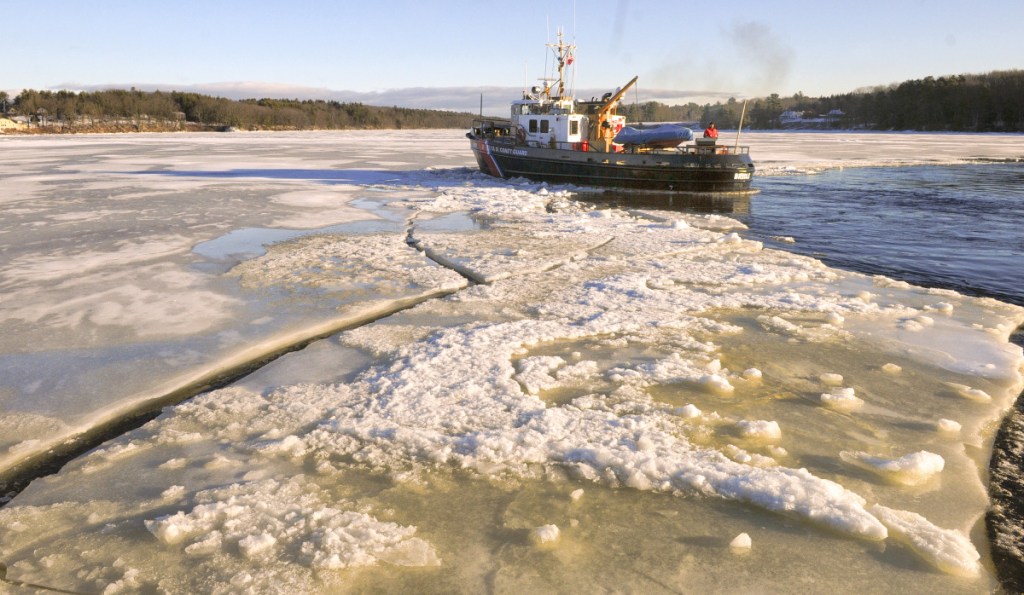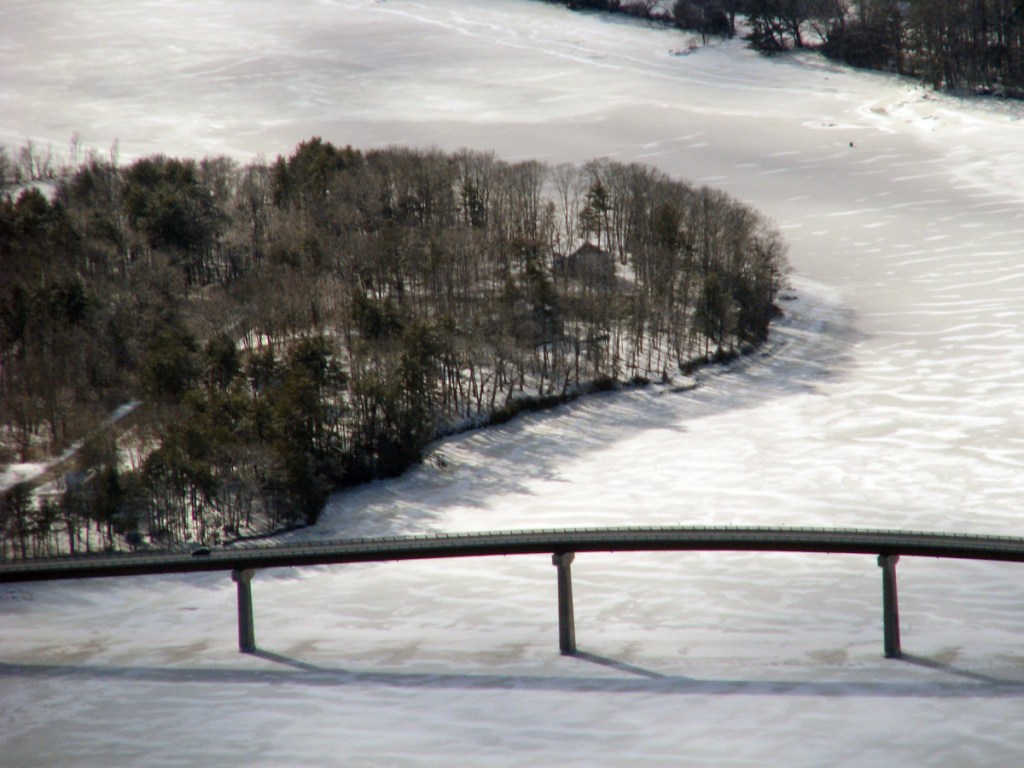The National Weather Service in Gray issued a flood warning through Friday afternoon for part of Augusta and Hallowell, Gardiner and Richmond because of the rising Kennebec River, while U.S. Coast Guard boats continue to push upriver in an unprecedented attempt at breaking up midwinter ice to ward against flooding.
By Thursday evening, the river’s water level had edged up to within striking distance of flood stage: 11.59 feet at the U.S. Geological Survey gauge at the Calumet Bridge at Old Fort Western in Augusta. Flood stage is 12 feet — and the river has been rising since falling below 10 feet earlier in the week.
Two U.S. Coast Guard cutters broke through nearly 350 yards of ice Wednesday morning on the southern Kennebec River and Merrymeeting Bay near Bowdoinham and Chop Point in Woolwich.
The early arrival of the icebreakers came as downtown Augusta and Hallowell remain vulnerable to midwinter river flooding like that caused by an ice jam Jan. 13-14 that stranded many vehicles and sent icy water into businesses.
The two vessels — the Rockland-based USCGC Tackle and the Southwest Harbor-based USCGC Bridle — were joined by another 65-foot cutter, the South Portland-based USCGC Shackle, on Thursday morning, and they were awaiting the arrival of a larger, 140-foot icebreaker, the USCGC Penobscot Bay, later in the day, according to Lt. Matthew Odom, chief of the Coast Guard’s Waterways Management Division in Northern New England.
“They were able to make further progress further up river during the tidal window this morning,” Odom said. “With the larger cutter in the area working in conjunction with the three 65’s, we’re expecting to make faster progress up the river.”
Meanwhile, the Kennebec County Emergency Management Agency also sent multiple messages Thursday about the rising river to its flood group, and other local officials alerted residents and businesses in the area.
The Augusta Police Department said the south end of Front Street has re-opened for parking, but the north end will be closed through the weekend.
“Augusta Public Works is making good progress with cleaning up the north end of Front Street, but there’s still much work to do,” Lt. Kevin Lully said. “The south end of Front Street has been ice-free for a few days.”
The weather service said an ice jam near Farmingdale continues to cause problems. Cold weather Wednesday night caused more ice to flow downstream and accumulate in Augusta, and even colder weather Thursday night was expected to result in more ice flowing into the jam.
This weekend’s forecast calls for high temperature in the 40s, which could result in additional melting.
“We are supposed to have some warm weather this weekend, which may influence melting and the river flow,” Lully said. “We ask that everyone continues to practice safety and avoid any open-water areas.”
According to the U.S. Geological Sunvey, there is about 16 to 18 inches of ice in Richmond just south of the bridge and 8 inches of ice near the center of the channel. In Gardiner, just south of the Cobbosseecontee Stream, there is 18 inches of ice on the left edge and about 14 inches in the middle. The ice is both spots is white and gray and there doesn’t appear to be any slush.
Andy Meyers, the Coast Guard’s chief of prevention for northern New England, said because the ice jam is upriver where the icebreakers can’t reach, it’s difficult to quantify how much of a difference the cutters are making; but every bit of the river that they open helps improve the flow.
Based on the tides and the water depth needed for safe transit, the four icebreakers will be in the lower portion of the river Friday, and Meyers said they should be in Richmond on Saturday morning.
“From there, our smaller icereakers will make sure the ice continues to flush down river, and they’ll also begin working from Richmond to Gardiner,” Meyers said. “Their progress will be largely dependent on the thickness of the ice they see.”
Anything over 12 inches, Meyers said, generally requires the more time-consuming ramming and backing method. Odom said the cutters will do whatever they can to get up to Gardiner, and the Coast Guard should have a better idea of the conditions from Richmond to Gardiner this weekend.
Chief Petty Officer Lia Chasteen said Wednesday she wasn’t aware of any previous ice-breaking operation on the Kennebec occurring this early in the year. The spring breakout usually happens in late March or early April. It didn’t happen the last two years, however, because warmer weather melted the ice before the Coast Guard was needed to break it.
The Coast Guard received a request a week ago from the Maine Emergency Management Agency to break out the ice on the Kennebec to ward off further flooding. The depth of the river and low height of the Pearl Harbor Remembrance Bridge linking Gardiner and Randolph limit the Coast Guard’s ability to reach the ice jam, but it will break ice to open up water downriver to improve the river flow, according to Lt. Matthew Odom, chief of the Coast Guard’s Waterways Management Division in Northern New England.
Chasteen said water was flowing when the vessels came up the river Tuesday, but they encountered ice and didn’t make it as far as they did Wednesday. She said there was probably 16 inches of solid ice with 2 to 3 inches of snow on top. There was about 6 inches to 1 foot of slush underneath that made it difficult to break, she said.
The 140-foot Penobscot Bay is longer and heavier, which is beneficial for the ramming and backing process, Chasteen said, but it also has a bubbler system that warms the water around the hull.
Ramming and backing is a process in which the cutters go full speed toward the ice and use the weight of the cutter to smash the ice underneath the hull.
Jason Pafundi — 621-5663
Twitter: @jasonpafundiKJ
Send questions/comments to the editors.






Comments are no longer available on this story